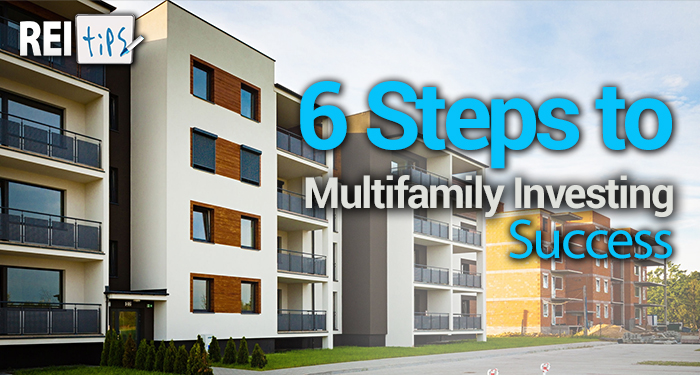Good news—you can. But is multifamily investing really every real estate investor’s dream? And how do you find the multifamily property that’s sure to be a win for you and your private money lenders?
Before we dive into the steps to apartment investing success, we need to start with the pros of investing in multifamily properties.
First, The Money
Of course, the most obvious (and attractive) pro is the money. If you’re collecting rent from ten families or 50 families or 100 families, you’re going to make more money than if you’re collecting rent from one family in a single-family home.
But it’s not just about the number of rent collections. There’s the multiplication factor. If you’ve got one tenant and you raise the rent 3%, that doesn’t add up to much for you. But if you have 10 tenants and you raise all of their rent rates 3%, your cash flow is going up by hundreds instead of tens. And consider what happens when you have 100 tenants and you raise the rates even 1%.
Your tax benefits also multiply. You can apply depreciation, including the depreciation of each set of appliances in each rental unit, to your cash-on-cash return (they sure don’t last forever). All of that adds up to a huge tax benefit.
Your maintenance and repair bill goes up with a multifamily property. But you’re also only maintaining one roof, one boiler system, and so on. And the cost of one roof split between 10 rental units is no big deal compared to one roof and one rent check.
Easy Peasy
Multifamily properties can be passive income generators (even more so than a single-family property). Why? Hire a property manager to take care of your property for you and suddenly your multi-million-dollar investment is generating income every month and you’re totally hands off.
Multifamily properties also tend to be less market dependent, so your investment is likely to continue generating the return you’ve been looking for without much variation (and more than likely an increase in value that will generate even more of a return).
Okay, all those benefits sound great, but how does this work practically? It’s time for the Steps to Multifamily Success.
1. Talk the Talk
When you jump into the multifamily investing business, you need to know what you’re doing….or at least sound like you do.
Spend time talking with other investors. Read as much as you can. Learn the terminology for multifamily investing so you can impress a broker and navigate multifamily investment conversations confidently.
And if you are new to multifamily investing, make sure you’re not going it alone. You should have people around you to ask questions and learn from, whether they’re other investors or mentors.
2. Learn How to Comp It
What makes a good multifamily property investment? One right answer is always location. Plus, a property needs to make sense compared to the comps.
Calculate the value of the property accurately. For smaller multifamily properties (such as duplexes) figure out the loan-to-value ratio. For larger properties, figure out the capitalization (cap) rate. The cap rate is the net operating income divided by the cost of the property.
Find a few similar multifamily properties near the property you’re considering and call the property manager to ask a few questions. Ask about the rent prices, vacancy rate, and any recent improvements. This will give you a few different insights. First, you’ll get an idea of how much you can probably charge; is that going to bring in enough of a profit?
Second, if the vacancy rate at the comp properties is high, you might need to rethink your investment. Maybe the location isn’t what you thought.
Third, recent improvements will give you an idea on what kinds of features renters are looking for. This is particularly important because the best kind of multifamily property to buy is an underperforming property.
If you can find a property that’s got plenty of potential but is being sold at a discount, you’ve got an opportunity to add value quickly. Maybe the long-term property owner hasn’t made any improvements in years and the vacancy rate is high. You can bring that down with some updates, especially if you know what’s attracted other local renters.
3. Where’s the Money?
As with all deals, you need to determine how you’re going to pay for your investment. There’s bank funding, and then there’s private money.
Keep it professional, in both funding situations. If you’re making a pitch, know your market research, know the property, and be ready with information from any property inspections. You want to be an expert, even on your first deal, as much as possible.
And as with all private money deals, networking is key. If you’re going the private money route, set up those relationships before you’ve got your first deal in play so that you’ve got people to call as soon as you’ve found a property. And get a system in place early to keep track of those relationships. Keep calling and checking in on investors.
At the multifamily property level, deals will run into the millions. This opens up a new opportunity for your private investors. You might find some investors at this level (investing half a million or a million) who want to be more involved. These could be retired or semiretired professionals who’ve always been interested in real estate but haven’t had the time.
With this group, consider setting up a more hands-on approach. Act as a coach to provide training on multifamily investing, offer guidance on setting goals for wealth generation, host private events such as guided tours of multifamily properties with explanations of the features you look for in a multifamily deal, and offer exclusive access to any new deals that come your way.
4. Persist…But Don’t Perspire
It’s normal to spend more time hunting for multifamily deals than for single-family properties. There aren’t as many out there, so it’s going to take more patience to find the right deal. Don’t sweat it if you’re not finding as many multifamily properties. Keep networking (look for relationships that might get you inside info on multifamily properties about to hit the market too) and hold out for the right deal.
5. Hire Talent
Once you’ve found that multifamily property and closed on it, turn the operation over to your property manager. This really should be a passive income generator, so take the time to hire someone you trust to run this property for you. Don’t try to do it all yourself or you won’t be able to continue to scale your operation. Remember how much time it takes to find a multifamily property and get started looking for your next investment.
But do stay in touch with your property manager. Keep them accountable and check in regularly to make sure your priorities are their priorities.
6. Pocket Some Pennies
Every property is going to break from time to time, so make sure you set aside some funds for unexpected repairs. Plus, plan for updates you know need to happen, like a new roof, plumbing work, or new windows.
Build some cushion into your initial funding; make sure you’ve got any early repairs and maintenance covered. Then, when you start collecting rent, set aside some of that (a good rule of thumb is 10% of what you expect to collect) to cover improvements.
Time to Hear from You
Do you have any multifamily properties in your portfolio? What’s been the secret to your multifamily investing success? Let me know below.




